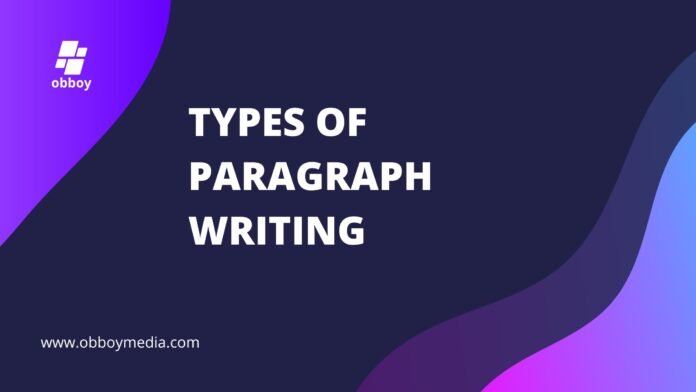
types of paragraph writing
Paragraph writing is an essential skill that students need to develop to communicate their thoughts and ideas effectively. Different types of paragraphs serve different purposes in writing. Here are some types of paragraphs that students need to know:
- Descriptive Paragraph: A descriptive paragraph describes a person, place, or thing in detail. It paints a picture using sensory details like sight, sound, smell, taste, and touch. For example, a descriptive paragraph about a beach could describe the sound of the waves crashing, the smell of saltwater, and the feel of the warm sand.
- Narrative Paragraph: A narrative paragraph tells a story or recounts an event. It has a beginning, middle, and end, and often includes dialogue and characters. For example, a narrative paragraph could describe a child’s experience at a birthday party.
- Expository Paragraph: An expository paragraph explains or informs about a topic. It presents facts, data, and information in a logical and organized way. For example, an expository paragraph could explain the process of photosynthesis.
- Persuasive Paragraph: A persuasive paragraph convinces the reader to take a particular action or believe a certain point of view. It presents arguments, evidence, and examples to support the writer’s position. For example, a persuasive paragraph could argue that students should have longer recess periods.
- Compare and Contrast Paragraph: A compare and contrast paragraph examines the similarities and differences between two or more subjects. It presents the information in a structured way and often uses transition words like “however,” “similarly,” and “in contrast.” For example, a compare and contrast paragraph could compare the benefits and drawbacks of living in the city versus the countryside.
In conclusion, mastering different types of paragraphs is an important skill for students to have. By understanding the purpose of each type of paragraph, students can communicate their thoughts and ideas effectively in their writing.
অনুচ্ছেদ লেখার ধরন
অনুচ্ছেদ লেখা একটি অপরিহার্য দক্ষতা যা শিক্ষার্থীদের তাদের চিন্তাভাবনা এবং ধারণাগুলি কার্যকরভাবে যোগাযোগ করার জন্য বিকাশ করতে হবে। বিভিন্ন ধরনের অনুচ্ছেদ লিখিতভাবে বিভিন্ন উদ্দেশ্যে কাজ করে। এখানে কিছু ধরণের অনুচ্ছেদ রয়েছে যা শিক্ষার্থীদের জানা দরকার:
বর্ণনামূলক অনুচ্ছেদ: একটি বর্ণনামূলক অনুচ্ছেদ একটি ব্যক্তি, স্থান বা জিনিসকে বিশদভাবে বর্ণনা করে। এটি দৃষ্টিশক্তি, শব্দ, গন্ধ, স্বাদ এবং স্পর্শের মতো সংবেদনশীল বিবরণ ব্যবহার করে একটি ছবি আঁকে। উদাহরণস্বরূপ, একটি সৈকত সম্পর্কে একটি বর্ণনামূলক অনুচ্ছেদ ঢেউ আছড়ে পড়ার শব্দ, নোনা জলের গন্ধ এবং উষ্ণ বালির অনুভূতি বর্ণনা করতে পারে।
বর্ণনামূলক অনুচ্ছেদ: একটি বর্ণনামূলক অনুচ্ছেদ একটি গল্প বলে বা একটি ঘটনা বর্ণনা করে। এটির একটি শুরু, মধ্য এবং শেষ রয়েছে এবং প্রায়শই সংলাপ এবং অক্ষর অন্তর্ভুক্ত থাকে। উদাহরণস্বরূপ, একটি বর্ণনামূলক অনুচ্ছেদ একটি জন্মদিনের পার্টিতে একটি শিশুর অভিজ্ঞতা বর্ণনা করতে পারে।
এক্সপোজিটরি অনুচ্ছেদ: একটি এক্সপোজিটরি অনুচ্ছেদ একটি বিষয় সম্পর্কে ব্যাখ্যা বা অবহিত করে। এটি একটি যৌক্তিক এবং সংগঠিত উপায়ে তথ্য, তথ্য এবং তথ্য উপস্থাপন করে। উদাহরণস্বরূপ, একটি এক্সপোজিটরি অনুচ্ছেদ সালোকসংশ্লেষণ প্রক্রিয়া ব্যাখ্যা করতে পারে।
প্ররোচক অনুচ্ছেদ: একটি প্ররোচক অনুচ্ছেদ পাঠককে একটি নির্দিষ্ট পদক্ষেপ নিতে বা একটি নির্দিষ্ট দৃষ্টিকোণ বিশ্বাস করতে রাজি করায়। এটি লেখকের অবস্থানকে সমর্থন করার জন্য যুক্তি, প্রমাণ এবং উদাহরণ উপস্থাপন করে। উদাহরণস্বরূপ, একটি প্ররোচক অনুচ্ছেদ যুক্তি দিতে পারে যে শিক্ষার্থীদের দীর্ঘ অবকাশের সময় থাকতে হবে।
তুলনা এবং বৈসাদৃশ্য অনুচ্ছেদ: একটি তুলনা এবং বৈসাদৃশ্য অনুচ্ছেদ দুটি বা ততোধিক বিষয়ের মধ্যে মিল এবং পার্থক্য পরীক্ষা করে। এটি একটি কাঠামোগত উপায়ে তথ্য উপস্থাপন করে এবং প্রায়ই রূপান্তর শব্দ ব্যবহার করে যেমন “তবে,” “একইভাবে,” এবং “বিপরীতভাবে।” উদাহরণস্বরূপ, একটি তুলনা এবং বৈসাদৃশ্য অনুচ্ছেদ শহর বনাম গ্রামাঞ্চলে বসবাসের সুবিধা এবং অসুবিধাগুলির তুলনা করতে পারে।
উপসংহারে, বিভিন্ন ধরণের অনুচ্ছেদ আয়ত্ত করা শিক্ষার্থীদের জন্য একটি গুরুত্বপূর্ণ দক্ষতা। প্রতিটি ধরণের অনুচ্ছেদের উদ্দেশ্য বোঝার মাধ্যমে, শিক্ষার্থীরা তাদের চিন্তাভাবনা এবং ধারণাগুলি তাদের লেখায় কার্যকরভাবে যোগাযোগ করতে পারে।
















